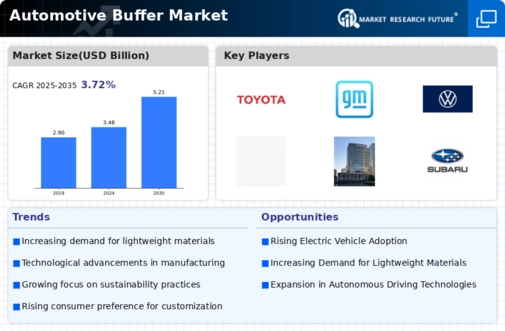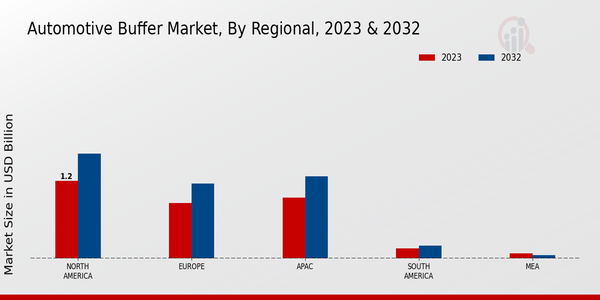Market Growth Projections
The Global Automotive Buffer Market Industry is poised for substantial growth, with projections indicating a market value of 3.48 USD Billion in 2024 and an anticipated increase to 5.21 USD Billion by 2035. This growth trajectory suggests a compound annual growth rate of 3.73% from 2025 to 2035. Such figures reflect the increasing demand for automotive buffers driven by various factors, including rising vehicle production, technological advancements, and a growing focus on safety. The market's expansion is indicative of the evolving automotive landscape, where buffers are becoming integral components in enhancing vehicle performance and safety.
Increasing Vehicle Production
The Global Automotive Buffer Market Industry is experiencing growth driven by the rising production of vehicles worldwide. As manufacturers ramp up output to meet consumer demand, the need for automotive buffers, which enhance vehicle performance and safety, becomes more pronounced. In 2024, the market is valued at approximately 3.48 USD Billion, reflecting the industry's response to increased vehicle assembly lines. This trend is expected to continue, with projections indicating a market value of 5.21 USD Billion by 2035. Such growth suggests a compound annual growth rate of 3.73% from 2025 to 2035, highlighting the importance of automotive buffers in modern vehicle design.
Expansion of Aftermarket Services
The Global Automotive Buffer Market Industry is also benefiting from the expansion of aftermarket services, which include the replacement and upgrading of automotive components. As vehicles age, the need for high-quality buffers becomes essential to maintain performance and safety. The aftermarket segment is witnessing growth due to increased vehicle ownership and longer vehicle lifespans. This trend is likely to enhance the demand for automotive buffers, contributing to the market's overall expansion. The anticipated growth trajectory, with a market value of 3.48 USD Billion in 2024 and a projected 5.21 USD Billion by 2035, underscores the importance of aftermarket services in the automotive buffer sector.
Rising Demand for Electric Vehicles
The shift towards electric vehicles (EVs) is a transformative trend impacting the Global Automotive Buffer Market Industry. As consumers increasingly opt for EVs, manufacturers are adapting their designs to accommodate the unique requirements of electric drivetrains. Automotive buffers are integral to ensuring the performance and safety of these vehicles, as they help manage vibrations and impacts. The growing EV market is expected to drive demand for specialized buffers, contributing to the overall market growth. With a projected market value of 5.21 USD Billion by 2035, the influence of electric vehicles on the automotive buffer sector is becoming increasingly evident.
Growing Focus on Vehicle Safety Standards
The Global Automotive Buffer Market Industry is significantly influenced by the increasing emphasis on vehicle safety standards across various regions. Governments and regulatory bodies are implementing stringent safety regulations, compelling manufacturers to enhance vehicle safety features. Automotive buffers play a crucial role in absorbing impact and reducing injury risk during collisions. As a result, the demand for high-quality buffers is expected to surge, contributing to the market's growth. This focus on safety aligns with the projected market valuation of 3.48 USD Billion in 2024, with expectations of reaching 5.21 USD Billion by 2035, reflecting a growing awareness of safety in automotive design.
Technological Advancements in Automotive Components
Technological innovations play a pivotal role in the Global Automotive Buffer Market Industry, as manufacturers increasingly integrate advanced materials and designs into their products. These advancements enhance the performance and durability of automotive buffers, making them essential for modern vehicles. For instance, the introduction of lightweight composite materials has improved the efficiency of buffers, leading to better fuel economy and reduced emissions. As the automotive sector continues to evolve, the demand for high-performance buffers is likely to rise, further propelling market growth. This trend aligns with the projected increase in market value, reaching 5.21 USD Billion by 2035.



























Leave a Comment